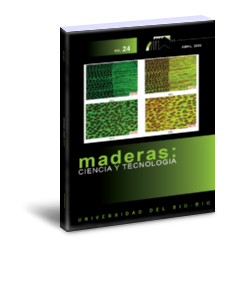Natural durability of five tropical wood species in field decay tests
DOI:
https://doi.org/10.4067/s0718-221x2022000100451Keywords:
Decay index, hardwood, natural resistance, outdoor use, wood logsAbstract
Measuring the natural resistance of wood is fundamental for proper use. The natural durability of five tropical wood species was investigated by field decay testing during exposure for 360 days. Wood logs (length of 0,5 m; diameter of 8 cm - 12 cm) were used in this study. The mass loss and decay index were calculated and visual analysis during the exposure time was performed for all samples. The samples presented evidence of two different groups concerning natural durability. The species in the first group (Mimosa caesalpiniifolia, Mimosa ophthalmocentra, and Mimosa tenuiflora) showed the highest resistance to biodeterioration, better or similar performance compared to treated eucalyptus wood (as control). The other group (Aspidosperma pyrifolium and Cordia oncocalyx) had lower natural resistance in outdoor service, being more susceptible to decay. In general, the wood of the first group is indicated for outdoor uses that require medium or prolonged exposure, such as timber stakes and fence posts.
Downloads
References
Araújo, J.B.S; Paes, J.B. 2018. Natural wood resistance of Mimosa caesalpiniifolia in field testing. FLORAM 25(2): e20150128. https://doi.org/10.1590/2179-8087.012815
Arnfield, A.J. 2020. Köppen climate classification. Encyclopedia Britannica. https://www.britannica.com/science/Koppen-climate-classification
Batista, F.G; Melo, R.R; Medeiros, D.T; Oliveira, A.G.S; Freitas, C.B.A; Silva, E.D.G; Pimenta, A.S. 2020a. Longitudinal variation of wood quality in the five forest species from Caatinga. Rev Bras Cienc Agrar 15(4): e8572. https://doi.org/10.5039/agraria.v15i4a8572
Batista, F.G; Melo, R.R; Calegari, L; Medeiros, D.T; Lopes, P.J.G. 2020b. Resistência natural da madeira de seis espécies à Nasutitermes corniger Motsch. em condição de campo. Madera y Bosques 26(2): e2622017. https://doi.org/10.21829/myb.2020.2622017
Brischke, C; Meyer-Veltrup, L. 2016. Modelling timber decay caused by brown rot fungi. Mater Struct 49(8): 3281-3291. https://doi.org/10.1617/s11527-015-0719-y
Clausen, C.A. 2010. Wood handbook: wood as an engineering material. Chapter 14: Biodeterioration of wood. Forest Products Laboratory (Ed.). FPL-GTR, Madison, USA. https://www.fpl.fs.fed.us/documnts/fplgtr/fpl_gtr190.pdf
Curling, S.F; Murphy, R.J. 2002. The use of the Decay Susceptibility Index (DSI) in the evaluation of biological durability tests of wood based board materials. Holz Roh Werkst 60: 224-226. https://doi.org/10.1007/s00107-002-0284-2
Dalla Costa, H.W; Candaten, L; Trevisan, R; Gatto, D.A. 2018. Durabilidade natural da madeira de duas espécies provenientes de floresta energética. Encicl Biosfera 15(28): 434-441. https://doi.org/10.18677/EnciBio_2018B120
Delucis, R.A; Cademartori, P.H.G; Missio, A.L; Gatto, D.A. 2016. Decay resistance of four fast-growing eucalypts wood exposed to three types of fields. Maderas-Cienc Tecnol 18(1): 33-42. https://doi.org/10.4067/S0718-221X2016005000004
Gonçalves, C.A; Lelis, R.C.C; Abreu, H.S. 2010. Caracterização físico-química da madeira de Sabiá (Mimosa caesalpiniaefolia Benth.). Rev Caatinga 23(1): 54-62. https://periodicos.ufersa.edu.br/index.php/caatinga/article/view/1348/pdf
Hassan, B; Mankowski, M.E; Kirker, G; Ahmed, S. 2017. Effects of heartwood extractives on symbiotic protozoan communities and mortality in two termite species. Int Biodeterior Biodegradation 123: 27-36. https://doi.org/10.1016/j.ibiod.2017.05.023
Instituto de Desenvolvimento Sustentável e Meio Ambiente do Rio Grande do Norte. 2008. Perfil do seu município. CES/IDEMA. Natal, Brazil. (In Portuguese)
Instituto Nacional de Meteorologia. 2020. Banco de dados meteorológicos. INMET. Brasília, Brazil. https://bdmep.inmet.gov.br/ (In Portuguese)
Karinkanta, P; Ämmälä, A; Illikainen, M; Ninnimäki, J. 2018. Fine grinding of wood – overview from wood breakage to applications. Biomass Bioenergy 113: 31-44. https://doi.org/10.1016/j.biombioe.2018.03.007
Kirker, G.T; Blodgett, A.B; Arango, R.A; Lebow, P.K; Clausen, C.A. 2013. The role of extractives in naturally durable wood species. Int Biodeterior Biodegradation 82: 53-58. https://doi.org/10.1016/j.ibiod.2013.03.007
Maia, J.H; Ferreira, L.M.M; Castro, V.G. 2020. Influence of extractives on the color of woods from Caatinga. Adv For Sci 7(2): 1043-1048. https://doi.org/10.34062/afs.v7i2.9421
Medeiros Neto, P.N; Paes, J.B; Oliveira, J.T.S; Silva, J.G.M; Coelho, J.C.F; Ribeiro, L.S. 2020. Durability of Eucalypts wood in soil bed and field decay tests. Maderas-Cienc Tecnol 22(4): 447-456. https://doi.org/10.4067/S0718-221X2020005000403
Meyer, L; Brischke, C; Melcher, E; Brandt, K; Lenz, M.T; Soetbeer, A. 2014. Durability of English oak (Quercus robur L.): comparison of decay progress and resistance under various laboratory and field conditions. Int Biodeterior Biodegradation 86(B): 79-85. https://doi.org/10.1016/j.ibiod.2013.06.025
Mounguengui, S; Saha Tchinda, J.B; Ndikontar, M.K; Dumarçay, S; Attéké, C; Perrin, D; Gelhaye, E; Gérardin, P. 2016. Total phenolic and lignin contents, phytochemical screening, antioxidant and fungal inhibition properties of the heartwood extractives of ten Congo Basin tree species. Ann For Sci 73(2): 287-296. https://doi.org/10.1007/s13595-015-0514-5
Oliveira, W.C; Pereira, B.L.C; Goes, L.S.A; Quintilhan, M.T; Oliveira, A.C; Môra, R. 2019. Deterioration of teak wood in accelerated decay test. FLORAM 26(2): e20170360. https://doi.org/10.1590/2179-8087.036017
Quintilhan, M.T; Oliveira, W.C; Oliveira, A.C; Pereira, B.L.C; Môra, R; Pinto, A.A.S. 2018. Deterioração da madeira de Eucalyptus e Corymbia em ensaio de campo. Ci Madeira 9(2): 82-94. https://doi.org/10.12953/2177-6830/rcm.v9n2p82-94
Ramage, M.H; Burridge, H; Busse-Wicher, M; Fereday, G; Reynolds, T; Shah, D.U; Wu, G; Yu, L; Fleming, P; Densley-Tingley, D; Allwood, J; Dupree, P; Linden, P.F; Scherman, O. 2017. The wood from the trees: the use of timber in construction. Renew Sust Energ Rev 68(1): 333-359. https://doi.org/10.1016/j.rser.2016.09.107
Schultz, T.P; Nicholas, D.D. 2000. Naturally durable heartwood: evidence for a proposed dual defensive function of the extractives. Phytochemistry 54(1): 47-52. https://doi.org/10.1016/S0031-9422(99)00622-6
Stallbaun, P.H; Barauna, E.E.P; Paes, J.B; Ribeiro, N.C; Monteiro, T.C; Arantes, M.D.C. 2017. Resistência natural da madeira de Sclerolobium paniculatum Vogel a cupins em condições de laboratório. FLORAM 24: e20160013. https://doi.org/10.1590/2179-8087.001316
Sundararaj, R; Shanbhag, R.R; Nagaveni, H.C; Vijayalakshmi, G. 2015. Natural durability of timbers under Indian environmental conditions: an overview. Int Biodeterior Biodegradation 103: 196-214. https://doi.org/10.1016/j.ibiod.2015.04.026
Tomazeli, A.J; Silveira, A.G; Trevisan, R; Wastowski, A.D; Cardoso, G.V. 2016. Durabilidade natural de quatro espécies florestais em campo de apodrecimento. Tecno-Lógica 20(1): 20-25. https://doi.org/10.17058/tecnolog.v20i1.6473
Valette, N; Perrot, T; Sormani, R; Gelhaye, E; Morel-Rouhier, M. 2017. Antifungal activities of wood extractives. Fungal Biol Rev 31(3): 113-123. https://doi.org/10.1016/j.fbr.2017.01.002
Downloads
Published
How to Cite
Issue
Section
License

This work is licensed under a Creative Commons Attribution 4.0 International License.
Los autores/as conservarán sus derechos de autor y garantizarán a la revista el derecho de primera publicación de su obra, el cuál estará simultáneamente sujeto a la Licencia de Reconocimiento de Creative Commons CC-BY que permite a terceros compartir la obra siempre que se indique su autor y su primera publicación esta revista.




































